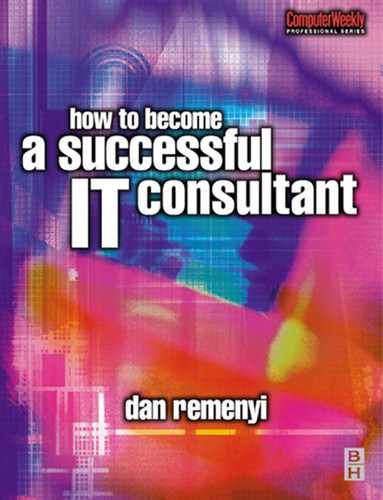Delivering results for the client |

There is nothing more difficult to take in hand, more perilous to conduct, or more uncertain in its success, than to take the lead in the introduction of a new order of things.
Nicolo Machiavelli, The Prince, 1532.
Getting a consultancy assignment done and done well can often be quite tricky. This chapter suggests some ideas to help you keep your clients happy.
8.1 IT consultancy assignments change
The result of a successful IT consulting assignment is that the client's business is in better condition than it was when the project commenced. This is achieved by the IT consultant delivering solutions to problems or helping clients take advantage of opportunities. It is about providing support for the business, which is not readily available internally. IT consulting assignments often involve working with some sort of change programme and these are often regarded as being some of the most difficult with which to succeed as they do not always have the wholehearted support of the individuals whose working lives are being changed. Furthermore these types of assignments often evolve or change themselves. You can begin with one set of objectives and quickly realize that you actually need to achieve something else. This can of course lead to both considerable opportunities as well as problems for the IT consultant. Thus delivering concrete results for the client, which the client actually appreciates as being of value, can often be quite a challenge.
There are several different challenges in establishing what the client actually needs and of course what the client actually needs may not be what the client wants. Sometimes the IT consultant will find him or herself caught between knowing what the client should do and having been given a specific job of work which is what the client wants. This is one of the many situations in which the IT consultant has to show a distinct penchant for diplomacy.
As mentioned before, consultancy work has to be done in such a way and at such a price that the client is convinced that he or she has obtained value for money. When expressed in this way it is obvious that from the client's perspective an IT consultancy project is an outsourcing arrangement whereby expertise or skills or a combination of both are being bought in to achieve a particular objective or a set of objectives. This being the case it is essential that the client play a central role in managing this consultancy process.1 Unmanaged IT consultants will not often produce their full potential value. Of course, sometimes the client is so tied up with other business matters that the IT consultant may be left on his or her own for extended periods. If this is the case then both the client and the IT consultant will find it useful to have an agreed method of working on the project and an agreed method of managing the assignment as a whole. This needs to be clearly stated right up front if potential misunderstandings are to be avoided. The key issue is that both parties need to know exactly what is going on and how both sides view the progress of the assignment. It is also essential that if any changes to the project be suggested that these are discussed as early as possible.
8.2 Active benefit realization
One such method involves regular feedback sessions to ensure that the consultancy objectives remain relevant and that the work performed continues to move towards a satisfactory solution to the problems is referred to as Active Benefit Realization (ABR).

… ENSURE THAT THE CONSULTANCY OBJECTIVES REMAIN RELEVANT …
ABR is an approach to project management and specifically to IT consultancy and development projects, which concentrates on achieving the maximum value from the project by focusing on the delivery of real business benefits. These benefits are achieved through a process of continuous involvement, in fact participation of both the IT consultants together with the client staff in achieving the project's objectives. This process relies on regular feedback and discussion of how the project is proceeding and whether the original objects of the project are still valid or relevant and is called continuous participative evaluation of the IT consulting assignment. ABR is an important approach to the management of IT consultancy assignments because it is relatively easy for such projects to stray off track.
ABR actually requires a partnership mind set whereby the IT consultant and the client see themselves working together to solve the problem or take advantage of the opportunity. ABR usually requires a broad focus on business issues underpinning the assignment, although the technical side of the project needs also to be carefully managed. This approach does not allow the client management to feel that the whole responsibility for the project rests with the IT consultants. Client management and the IT consultants are clearly jointly involved and they need to coensure both the success of the project and the delivery of benefits for the organization.
8.3 Formative evaluation

… REGULAR REVIEW MEETINGS …
As the IT consultancy project develops the IT consultant and the clients who are the principal stakeholders acquire a more comprehensive understanding of the actual challenges or opportunities presented by the original problem. They will then jointly guide the assignment through a process referred to as formative evaluation towards a solution that delivers real improvements or benefits for the organization. Formative evaluation is concerned with keeping projects focused on benefits and thus avoiding waste of resources. The concept is central to ABR because formative evaluation is the vehicle for sustaining a dialogue between the IT consultant and the client management, which ensures the desired outcome of the project. At one level formative evaluation may be seen as a process whereby all the relevant stakeholders in the IT consultant project may contribute their views and values as to how the assignment should proceed. This process requires regular review meetings during which an open attitude allows a comprehensive and meaningful discussion of all the key issues related to the assignment.
Formative evaluation provides a formal mechanism for improving project performance, which will take you through the whole duration of the project. Its objective is to improve project benefit delivery and ABR needs to be contrasted to those evaluations, which are done for the purpose of making basic decisions about whether or not the project has succeeded.2
The partnership mind set
It is actually very difficult for an IT consultant to achieve a partnership mind set with a client. The IT consultant is always an outsider (even if they have been working there for quite a long time) and there will inevitably be a degree of suspicion of the consultant's motives and possibly also a degree of jealousy. However, the only way to achieve the partnership mind set is to put time into understanding the client organization thoroughly and also the personal aspirations and ambitions of the client manager with whom you are working. This is both difficult and time consuming but it can actually be a critical success factor for your project.
The term formative is taken from the word form, ‘to mould by discipline and education’. Formative evaluation is viewed as a reiterative evaluation and decision-making process continually influencing the project and influencing the participants, with the overall objective to achieve more beneficial outcomes from the project. Because of its ongoing nature, which relies on evaluation continuous feedback, formative evaluation is sometimes referred to as learning evaluation which highlights that both the client and the IT consultant often need to learn what are the real needs of the organization.
8.4 Welcome change suggestions
To be successful with formative evaluation it is necessary to establish a mind set, which welcomes suggestions of possible change. It is also most important that there is no attempt to limit the source of such suggestions to executives only. The views of all competent stakeholders3 should be carefully listened to. Sometimes formative evaluation is referred to as learning evaluation as its intent is to improve performance and thus achieve a more satisfactory outcome.
8.5 Financial implications
Sometimes the ABR approach throws up the need for material changes to the IT consultancy assignments. It is usually much better to know about this during the assignment rather than at the end when it may be too late to do anything about the situation. However, sometimes these changes mean that the IT consultant will have to do extra work and the question, which always arises, is who will pay for this. If the IT consultancy assignment is on a time and materials basis then there is normally no problem. However, if there is a fixed price associated with the work then it may be necessary to negotiate a new price for the work. If the changes are necessary to accommodate new business circumstances there is usually no problem with this.

… CHANGES MEAN THAT THE IT CONSULTANT WILL HAVE TO DO EXTRA WORK …
8.6 Complements traditional project management
This ABR process complements traditional project management and financial management techniques that are necessary to ensure sound management practice for successfully delivering an IT consultancy outcome. Thus to be successful you will also need to use the standard project management techniques a number of which were discussed in the previous chapter.
Delivering real benefits for clients is not a trivial issue. IT consultancy projects can and do go wrong. As an IT consultant you just cannot assume that because you have a signed contract you actually know exactly what is needed and what will be acceptable. There can be a difference between what the client wants and what is truly needed by the organization and bringing these two together can be problematical.4 You need to continuously check that the project is on track. In this respect perceptions count for much more than any ‘reality’. In fact some would argue that the only reality is perception. It is always very important to remember that beauty, contact lenses and your competence are all in the eye of the beholder. If for whatever reason your client does not think that you are delivering benefit then you will not be seen as value for money. The value for money proposition is what underpins successful IT consulting and if your client is unconvinced about this then no matter how clever your work has been it is unlikely that your project will be considered a success.5
The techniques described in this chapter will help you make sure that this does not happen and that the client feels satisfied with the result of the assignment.
8.7 Summary and conclusion
Don't underestimate the difficulty in achieving a successful outcome to an IT consultancy assignment. To succeed you need to stay close to the client and to understand how his or her requirements change during the course of the project. This chapter suggests a technique called Active Benefit Realization to help you with this. For a full account of Active Benefit Realization see Achieving Maximum Value from your Information Systems – A Process Approach by Dan Remenyi, Michael Sherwood-Smith with Terry White published by John Wiley and Sons. The full reference is given in the reading list (Appendix A).
8.8 Checklist
Things to think about when delivering results for the client
1 Have you listed all the deliverables as stated in the contract?
2 Are there any other deliverables that are required but not specifically mentioned?
3 Do you know precisely when these are required?
4 Have you told your client about Active Benefit Realization and Formative Evaluation?
5 Have you established an understanding with your client as to how you will handle any changes to the contract?
6 Have you discussed how changes will be charged?
1 If the client is indifferent to the IT consultancy project and refuses to play a central role in its planning and control then you should prepare yourself for problems. Consultants can seldom achieve real results on their own. They really do need the involvement of the client management and other members of staff.
2 Evaluations conducted for the purpose of making decisions about whether or not the project has succeeded are referred to as summative evaluations. The term summative evaluation is derived from the word sum and is viewed as an act of evaluation assessing the final (sum) impact of a project or an investment. Summative evaluation normally focuses on a brief answer, which is that the project has either succeeded or failed. Formative evaluation gives a longer response as to how to proceed to ensure the successful delivery of benefits.
3 It is a considerable challenge to all consultants to know who are the most competent or the most knowledgeable individuals in the client firm. There is often an unfortunate assumption that the more senior the person the more competent and knowledgeable he or she is. This is clearly not always true but it can be difficult to be seen taking the word of someone junior before his or her superiors.
4 The potential gap between what the client wants and what the organization may actually need is a dilemma that IT consultants have to face from time to time. There is no easy answer as to what to do if this gap appears. Less experienced consultants will argue that you should actively point out to the client that he or she has not really understood the situation and that you can achieve better results if the client follows the consultant's advice, i.e. interpretation of the situation. More cynical consultants will simply say ‘just do what the client wants as he who pays the piper calls the tune’. Others will try to compromise and suggest that it is often useful to debate the difference between what is wanted and what might be needed and try to find a middle course. I would always favour some discussion on this issue but from practice I have personally found that the client often knows just what he or she wants and the consultant's suggestion that something else is needed is often not very welcome. This is always a very challenging area.
5 The value for money issue will raise its head again and again. This is because consultants were generally and naturally more expensive than full-time members of staff. This will inevitably be the case, as consultants always have to pay much of their own expenses that the firm pay out invisibly for the full-time member of staff. And many organizations worry about the fact that larger sums are paid to consultants.

